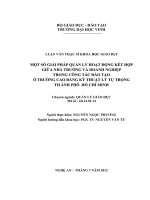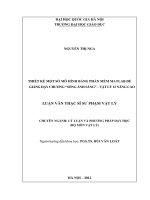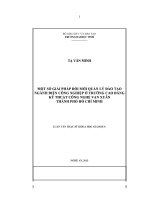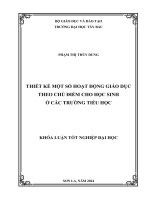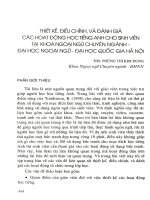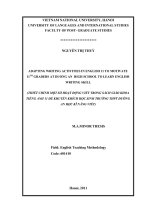Thiết kế một số hoạt động nói bổ sung cho giáo trình “Lifelines Elementary” cho sinh viên năm thứ nhất Trường cao đẳng Kỹ thuật mỹ nghệ Việt Nam
Bạn đang xem bản rút gọn của tài liệu. Xem và tải ngay bản đầy đủ của tài liệu tại đây (2.03 MB, 74 trang )
VIETNAM NATIONAL UNIVERSITY, HA NOI
UNIVERSITY OF LANGUAGES AND INTERNATIONAL STUDIES
FACULTY OF POST - GRADUATE STUDIES
----------
ĐOÀN THỊ LÊ
DESIGNING SOME SUPPLEMENTARY SPEAKING ACTIVITIES TO
THE COURSE BOOK “LIFELINES ELEMENTARY” FOR THE FIRST
YEAR STUDENTS OF VIETNAM VOCATIONAL COLLEGE OF
TECHNIQUE – CRAFT ART
THIẾT KẾ MỘT SỐ HOẠT ĐỘNG NĨI BỔ SUNG CHO GIÁO TRÌNH
“LIFELINES ELEMENTARY” CHO SINH VIÊN NĂM THỨ NHẤT TRƯỜNG
CAO ĐẲNG NGHỀ KỸ THUẬT MỸ NGHỆ VIỆT NAM
M.A. MINOR THESIS
FIELD: ENGLISH TEACHING METHODOLOGY
CODE: 601410
SUPERVISOR: PHAN THI ̣ VÂN QUYÊN, M.A
HA NOI - 2012
TABLE OF CONTENTS
Declaration……………………………………………………………………. i
Acknowledgement……………………………………………………………. ii
Abstract……………………………………………………………………...... iii
Abbreviations…………………………………………………………………. iv
List of figures, tables and charts……………………………………………… v
Table of contents……………………………………………………………… vi
Part A: INTRODUCTION ............................................................................... 1
1. Rationale of the study ...................................................................................... 3
2. Aims of the study ............................................................................................ 4
3. Research questions .......................................................................................... 4
4. Scope of the study .......................................................................................... 4
5. Research methods ............................................................................................ 5
6. Design of the study .......................................................................................... 6
Part B: DEVELOPMENT ................................................................................ 7
Chapter 1: THEORETICAL BACKGROUND .............................................. 7
1.1. Language skills and speaking ....................................................................... 7
1.1.1. Language skills .......................................................................................... 7
1.1.2. Speaking .................................................................................................... 8
1.1.3. Speaking activities ................................................................................... 11
1.2. Evaluation and supplementation of speaking activities and materials ......... 16
1.2.1. Evaluation of the activities and materials ................................................. 16
1.2.2. Supplementation of activities and materials ............................................. 17
1.2.2.1. Definition of supplementation .............................................................. 17
1.2.2.2. Forms of supplementation…………………………………………… 16
iv
1.3.
Previous studies....................................................................................... 18
Chapter 2: METHODOLOGY ....................................................................... 21
2.1. The research context ................................................................................... 21
2.1.1. The English teaching and learning situation at VVC TCA ....................... 21
2.1.2. The students at VVC TCA ....................................................................... 22
2.1.3. The teachers at VVC TCA ....................................................................... 22
2.2.1. An overview of the course book “Lifelines Elementary (Tom Hutchinson,
Oxford University Press, 2002) ......................................................................... 22
2.2. Research methods ...................................................................................... 25
2.2.1. Subjects of the study ................................................................................ 25
2.2.2. Research methods .................................................................................... 26
2.2.3. Data collection instruments ..................................................................... 26
2.2.4. Procedure of data collection .................................................................... 27
Chapter 3: DATA ANALYSIS AND FINDINGS .......................................... 28
3.1. Students‟ background of English learning: ................................................. 28
3.2. Current situation of English teaching and learning ..................................... 28
3.3. The evaluation of the speaking activities in the course book by teachers and
students. ........................................................................................................... 30
3.4. Students‟ needs when learning speaking skills............................................ 33
Chapter 4: DESIGNING SOME SUPPLEMENTARY SPEAKING
ACTIVITIES TO THE COURSE BOOK “LIFELINES ELEMENTARY”
AT VVC TCA .................................................................................................. 36
4.1. Supplementary speaking activities for unit 1 and unit 2 .............................. 36
4.2. Supplementary speaking activities for unit 3 .............................................. 38
4.3. Supplementary speaking activities for unit 4 & Extension unit 3 and 4 ..............39
v
4.4. Supplementary speaking activities for unit 5 .............................................. 40
4.5. Supplementary speaking activities for unit 6 .............................................. 41
4.6. Supplementary speaking activities for unit 7 .............................................. 41
4.7. Supplementary speaking activities for unit 11 ............................................ 42
4.8. Supplementary speaking activities for unit 12 ............................................ 43
4.9. Supplementary speaking activities for unit 14 ............................................ 44
Part C: CONCLUSION .................................................................................. 45
1. Conclusion .................................................................................................... 45
2. Limitations of the study and suggestions for further study ............................. 46
REFERENCES ................................................................................................ 47
APPENDIX....................................................................................................... I
vi
ABBREVIATIONS
VVC TCA Vietnam Vocational College of Technique and Craft – Art
CLT
Communicative Language Teaching
GE
General English
ESP
English for Specific Purposes
MA
Master of Art
1
LISTS OF FIGURES, TABLES AND CHARTS
Page
1. Figures
Figure 1: The four – macro skills…………………………………………...
5
2. Charts
Chart 1: Students‟ background of learning English………………………...
26
Chart 2: Frequency of using supplementary speaking activities designed by
teachers……………………………………………………………………..
26
Chart 3: Evaluation about the topics of speaking activities………………...
29
Chart 4: Evaluation about the types of speaking activities…………………
29
Chart 5: Evaluation about the level of difficulty of speaking activities…….
30
Chart 6: Evaluation about the number of speaking activities……………….
31
Chart 7: Students‟ preference to practice speaking in class………………...
32
3. Tables
Table 1: Patterns of speaking activities teachers often use to teach speaking
27
skills in classroom…………………………………………………………..
Table 2: Difficulties students encounter when learning the speaking section
in the course book…………………………………………………………..
28
Table 3: Students‟ response to supplementary speaking activities…………
32
Table 4: Students‟ and teachers‟ preference for the types of speaking
activities…………………………………………………………………….
2
33
Part A: INTRODUCTION
1. Rationale of the study
Because of the economic development and the social, cultural integration
between the countries, English has become a very popular communicative means
in the modern world. In Vietnam, English is considered as one of the most vital
working tools in most of the career requirements.
English language has been taught and learnt widely for a long time in
Vietnam. However, most of the learners cannot use English naturally and
frequently and they have not achieved the high communicative effect in English.
There exist many reasons for this situation. In the high school, English has been
taught as the compulsory subject, but learners have not been motivated in using
English as the essential means. In addition, although learners can be aware of the
importance of English, they have not been put the suitable environment to
communicate in English. The other reason is that the way of the English
teaching. The Vietnamese teachers of English have been facing many arising
difficulties. Materials used in teaching are one of the shortcomings constraining
the effect of English teaching. Most of the teachers followed all of the activities
in the course book without adapting and designing to suit students‟ abilities,
levels and needs. Although learners spent a lot of time on learning English, their
linguistic competence, especially the speaking skill, has not been effective. As a
result, the appropriate choice of the materials as well as the language activities is
very important for learners to improve language skill.
The major purpose of teaching and learning English has focused on the
development of communicative approach. All the speaking activities should be
designed with the aim of helping students find out the easy way to practice
3
speaking English effectively. It is the fact that students felt bored with the
current materials and have not learned how to speak at the time of high school,
so their speaking ability is mostly poor. Thus, when teaching English, teachers
should concentrate on the communicative competence in order to help students
develop the English speaking skill better in daily life. Thus, it gives the author
great motivation to choose the study “Designing some supplementary speaking
activities to the course book “Lifelines Elementary” for the 1st year students at
VVC TCA”.
2. Aims of the study
The main aims of the study are as the following:
- To review theories of teaching speaking skills, especially speaking activities
and supplementary materials.
- To evaluate speaking section of the course book “Lifelines Elementary”.
- To clarify the reasons why the speaking activities in the course book should be
added to suit students‟ levels and needs.
- To design some appropriate supplementary speaking activities to the course
book “Lifelines Elementary” for the 1st year students of the Vietnamese
Vocational College of Technique – Craft Art.
3. Research questions
The following research questions will be stated in the study to get the above
objectives:
1. How do teachers and students at VVC TCA evaluate speaking section
of the course book “Lifelines Elementary”?
4
2.What difficulties and needs do the 1st year students have in learning
speaking skills on the course book “Lifelines Elementary” at VVC TCA?
3.What needs do the 1st year students have in learning speaking skills on
the course book “Lifelines Elementary” at VVC TCA?
4. Scope of the study
There are many different features related to speaking activities used to teach
speaking skills. However, my study is mainly focused on designing some
supplementary speaking activities to the course book for the 1st year students
based on the analysis of their difficulties and needs in learning speaking in order
to create a more interesting, active speaking environment and thus, improve
students‟ speaking skills.
5. Research methods
This thesis is carried out using the combination of quantitative and
qualitative methods. Survey questionnaires, observations, interview are used to
collect data for the research.
- Questionnaires are delivered to 100 VVC TCA 1st students and 5 teachers to
find out the current English teaching and learning situation, their responses as
well as their needs in learning speaking and to find out the kinds of the speaking
activities which interest students the most.
- Personal observation, informal interviews are implemented to increase the
reliability of the obtained information from the questionnaires and to provide
more subjective information relating to the speaking activities used by teachers.
- The data collected are analyzed. The findings are critically discussed and then
used as the basis and suggestions for designing some supplementary speaking
activities.
5
6. Design of the study
The thesis consists of three main parts:
Part A: INTRODUCTION presents an overview of the study with rationale
aim, scope, research questions and methods of the study.
Part B: DEVELOPMENT consists of 4 chapters:
Chapter 1: Theoretical background provides some theoretical background
related to speaking skill and speaking activities as well as the supplementary
process of speaking activities.
Chapter 2: Methodology focuses on the subjects, research methods, data
collection instruments and procedures of data collection applied in the study.
Chapter 3: Data Analysis and Findings
In this chapter, an analysis on the students‟ background of learning English;
the evaluation of the speaking activities and needs in learning and teaching
speaking skills by students and teachers is also carried out through data analysis
and presentation according to research. In addition, the findings and discussion
are illustrated clearly.
Chapter 4: Designing supplementary speaking activities
In this chapter, some helpful samples of supplementary speaking activities
are presented due to the speaking section of each unit in the course book
“Lifelines Elementary”.
Part C: CONCLUSION presents the concluding summary of main findings and
some recommendations on designing some supplementary speaking activities in
the study together with the limitations of the study and suggestions for further
research.
6
Part B: DEVELOPMENT
Chapter 1: THEORETICAL BACKGROUND
1.1. Language skills and speaking
1.1.1. Language skills
In language teaching, we often mention the four language skills (speaking,
listening, reading and writing) in term of their direction and modality.
Widdowson (1978: 1) states that “The aims of a language teaching course are
very often defined with reference to the four language skills: understanding
speech (listening), speaking, reading and writing”. However, speaking is the
skill generating more controversy. According to Savignon (1991) and Byrne
(1991), speaking and writing are considered as the productive skills in which the
learners generate language while listening and reading are known as the
receptive skills whose purpose is to comprehend or understand what someone
might be saying and writing. Moreover, Byrne (1991: 8) shows the relationship
of language skills through the following table:
Figure 1: The four – macro skills
Spoken language
Understanding
Receptive skills
Speaking
Reading
Writing
Productive skills
Written language
In addition, Ur (1996: 120) states that speaking seems intuitively the most
important and whoever can be able to use a language are referred to as
“speakers” of that language. It is certain that students are good at speaking skill;
he might feel confident and motivated to use English in classroom and real - life
communication without inhibition. Moreover, he will be ready for participation
7
in every different, flexible situation. This thing leads the other skills improved as
well. The learner who feels interested in speaking means that he will have a high
motivation in learning English. It will certainly foster his language competence.
Thus, teachers should provide students the supportive speaking environment to
help them have higher willingness in speaking English. This depends so much on
the way teachers creatively prepare more and more effective speaking activities
in each lesson.
Furthermore, language skills are often related to each other in use. In learning
English as a foreign language, students cannot develop speaking skill if they
don‟t improve listening skill. To have a good communication, people must
understand everything what is spoken. Furthermore, a variety of knowledge is
illustrated while learners make communication.
In short, all the four skills are equally important to the learners. It cannot be
denied that speaking skill must not be isolated from the others. Certainly,
learners‟ success in language learning, together with the effectiveness of their
English course is evaluated on the basis of how much they feel they have
improved in their spoken language proficiency.
1.1.2. Speaking
Bygate (1987) says that speaking is considered as a skill, not just knowledge
because the speakers not only know how to make utterances and adapt them to
each circumstance but also have a skill of making fluent conversations.
Moreover, he distinguished the term of “skill” into two basic ways: “motor perceptive skills” and “interaction skill”. He clarifies that the former involves
perceiving, recalling, and articulating in the correct order sounds and structures
of the language and the later is the skill of using both knowledge and motor 8
perceptive skills to achieve communication. Furthermore, interaction skills can
involve the management of interaction which illustrates the way to make
communication smooth and the negotiation of meaning which considers about
how utterances are understood explicitly.
The researchers‟ view of language teaching approaches and methods has
changed. Thus, it has affected the way of teaching speaking. According to
traditional methods, speaking skill usually seems to be taught as repeating after
the teacher, memorizing a dialog, or responding to drills, all of which reflect
the sentence-based view of proficiency prevailing in the audio - lingual a nd
other drill - based or repetition - based methodologies of the 1970s. Mackey
(1965: 266) pointed out that a good speaker is considered as being good at
choosing the right forms; putting them in the correct order, sounding like a
native speaker; even producing the right meanings. He also gave a list of the
practicing exercises such as “model dialogues, pattern practice, oral drill tables,
look - and - say exercises, and oral composition”. However, the emergence of
communicative language teaching in the 1980s led to changed views of
syllabuses and methodology, which are continuing to influence approaches to
teaching speaking skills today. Fluency became a goal for speaking courses and
this could be developed through the use of information - gap and other tasks that
required learners to attempt real communication, despite limited proficiency in
English. In so doing, learners would develop communication strategies and
engage in negotiation of meaning, both of which were considered essential to
the development of oral skills as well as focusing on the learner - centered
objective.
9
Furthermore, Brown and Yule (1983) made a useful distinction between the
interactional functions and the transactional functions of speaking. The former
serves to establish and maintain social relations while the latter focuses on the
exchange of information.
In addition, Bygate (1987) suggests that oral interactions can be characterized
as routines. Information routines contain frequently recurring types of
information structures, being either expository (e.g.: narration, description,
instruction, comparison) or evaluative (e.g.: explanation, justification, prediction,
decision). Interaction routines can be either service such as job interview or
social such as dinner party.
Another distinction when considering the development of speaking skills is
between monologue and dialogue. According to Richard, he expanded Brown
and Yule‟s framework (after Jones (1996) a n d Burns (1998)) and classified the
functions o f speaking as interaction; transaction and performance. In his
research, each of these speech activities is quite distinct in terms of form and
function and requires different teaching approaches. Understanding these
aspects of oral language helps the interlocutor be confident speakers of a foreign
language. They may be helpful for organizing our classrooms, evaluating our
learners‟ evaluating our learners‟ performance, especially for developing oral
activities in the classroom and real - life communication. However, the
Vietnamese students‟ abilities of using English as a tool in the real - life situation
are not still good. It is the fact that many teachers of English have focused on
mostly teaching vocabulary and grammar with the main purposes of preparing
the students for examinations. Although students may have a good knowledge of
grammar and a wide range of vocabulary, they cannot communicate in English
10
fluently. The lessons of practicing speaking skill are neglected in many
classrooms. These things can explain why most of the Vietnamese students are
not confident in their abilities of speaking English.
As a consequence, determining the well - prepared speaking practice is one
of the major challenges confronting both the teachers and the students.
Therefore, the next part will present a clear understanding of speaking activities.
1.1.3. Speaking Activities
Many researchers propose a great number of interaction activities due to
topics; information routines; interaction routines; or in terms of behavioral
criteria such as whether one person is being asked to draw something, make
something or arrange something. Therefore, a lot of oral activities are designed
due to the theory and characteristics of CLT.
LittleWood (1981) suggests the two sets of activities. The first type is
“functional communication activities” involving only communication of
information in which the learners identify similarities and differences in a set of
pictures, discover missing features in a map or picture, reconstruct story
sequences or problem-solving tasks. The second type is “social interaction
activities” in which the learners use English as a teaching and learning medium
in order to implement conversation, discussions sessions, dialogues, role plays,
stimulation, improvision and debates in classroom context. Similarly, Harmer
(1983) makes a distinction between “practice” activities and “communicative”
activities in which oral “practice” activities include “oral drills, information gap
activities, games, personalization and localization, oral activities” and
“communicative” activities consist of “reaching a consensus, relaying
instructions, communicative games, problem - solving, interpersonal exchange,
11
story construction, simulation and role play”. What‟s more, activities may also
be clarified as activities for accuracy that aim at learners‟ competence in
producing right words, phrases or sentences and activities for fluency that aim at
learners‟ capacity to maintain the flow of speech with ease and comfort.
When designing speaking activities properly, the teacher should be aware of
students‟ English proficiency levels. With each level, the teacher should consider
the different types of syllabus, methods, techniques as well as speaking materials
and types of activities at each procedure of language teaching. Byrne suggested
that the speaking teaching for the elementary level concentrates on accuracy
more than fluency. This is opposite to the advanced level at which the students
satisfy the requirements of daily situations and can communicate facts casually
as well as being able to describe with some detail, linking sentences together
smoothly.
Classroom speaking activities which develop learners‟ ability to express
themselves through speech would therefore seem an important component of a
language course. Successful speaking activities in class can have a great effect
on improvement of students‟ speaking skills. As a result, teachers should try to
design and administer activities. As is discussed in Ur (1996: 120), we can see
four characteristics of a successful activity:
“1. Students talk a lot: As much as possible of the period of time allotted to
the activity is in fact occupied by student talk. This may seem obvious, but often
most time is taken up with teacher talk or pauses.
2. Participation is even: Classroom discussion is not dominated by a
minority of talkative participants; all get a chance to speak and contributions
are fairly evenly distributed.
12
3. Motivation is high: Students are eager to speak because they are interested
in the topic and have something new to say about it, or because they want to
contribute to achieving a task objective.
4. Language is of an acceptable level: Students express themselves in
utterances that are relevant, easily comprehensible to each other, and of an
acceptable level of language accuracy.”
In addition, Ur (1996: 121) describes some problems happening to the
students. Firstly, they are often inhibited about trying to say something in
English in class, but they are often worried about making mistakes, fearful of
criticism or losing face, or simply shy of the attention that their speech attracts.
Secondly, even though they are not inhibited, they cannot think of anything to
say or have no motive to express themselves. Thirdly, some students have low
participation in the speaking practice. Furthermore, in classes, the mother tongue
often dominates while the target language is simply neglected. Knowing these
things can help teachers understand and design speaking activities carefully to
avoid these problems.
It can be seen that all speaking activities can be characterized as more or less
interactive. The students can easily achieve the goals of speaking skills by the
way of practicing from the controlled activities to communication activities. The
repetition and reading aloud play the important parts of practicing speaking skills
and building confidence and automaticity. However, these above things are not
just enough because they also want to communicate in English naturally. The
better way to motivate learners communicate each other is putting them in pairs
or small groups. For these reasons, it is crucial for teachers to provide more and
more interesting speaking activities for students to practice creative uses of the
13
language, so the following are some applicable types of speaking activities
which are used more easily and helpfully at the elementary level.
Dialogue
This type is mostly suitable for the beginning level learners. It is known as “a
short conversation between two people presented as a language model”
(Dobson, 1992: 35). It gives students opportunities to practice and revise the
rhythm, intonation as well as the speech sounds correctly. However, the dialogue
model on each topic provides interaction between two or more speakers in a real
- life situation. Through practicing dialogue, students are able to know how to
express ideas in such variously communicative context. Teachers prepare some
kinds of dialogues, for examples picture sets, model dialogue with keywords,
gapped dialogues or mapped dialogues. These things can help students avoid
being uninterested in closely modeled dialogues.
Information - gap
This activity is one of the easiest and most interesting forms of
communicative activity in the speaking class. The students can implement by the
way in which one person shares information which the others don‟t know in pair
or group work. This kind may encourage students‟ thoughts and highly motivate.
Some similar kinds can be collaboratively used named “Describe and Draw”.
Discussion
According to Ur (1996), discussion is the most natural and effective way for
students to talk freely in English by thinking out some problems or situations
together through verbal interchange or ideas. Teachers can give learners open ended questions or a list of topics and then ask them discuss in pairs or small
groups or talk freely. Particularly, in discussion, students can express and share
14
ideas or opinions in constructive and cooperative atmosphere without
threatening. There are different types of discussion activities such as describing
pictures, picture differences, things in common, solving a problem.
Role - play
This activity is really useful to involve the learners into the realistic situation;
but when practicing this speaking type, the teacher should be careful when
giving the suitable role for each participant due to his personalities. Byrne (1986)
suggests that the teacher can provide a guideline for role - play practice such as
open - ended dialogues, mapped dialogues, role instructions, and scenarios with
the aim of helping learners fulfill their roles creatively. It can be often happened
in pairs. It can be greatly effective if the students are confident and cooperative
because they perform comfortably with their capacity, enthusiasm and well prepared presentation and instructions.
Interview
Students interview each other using questions given by the teacher or made
by them. This activity is really useful to practice speaking and listening skills. It
is also helpful when giving students chances in working - situational speaking
environment. Likely, questionnaires and quizzes can be designed relating to a
topic of some kind such as likes and dislikes about food, leisure activities.
Students may interview more than one student. After that, they are asked to
report the results of what have been learned.
Furthermore, for the higher English proficiency level, students can be put in
the other following types of speaking activities:
15
Communication game
Communication games are based on the principle of the information gap.
Students are put into situations which are “game - like” and have to use all and
any language they possess to complete the game.
Stimulation
The idea of stimulation is to create the presence of a real - life situation in the
classroom. Thus, for example, we ask our students to pretend that they are at an
airport, or we ask them to get together to organize a union. What we are trying to
do very artificially, is give the students practice in real - life English, as it should
be used in English speaking environment. The stimulation has the advantage of
involving a large number of students at the same time. Examples of stimulation
are the travel agent, arranging a meet or the job interview.
In addition, when implementing these speaking activities, teachers can need
the help of visual aids. That‟s something visible to students, which the teacher
uses for different teaching purposes, especially speaking. They may be objects,
pieces, pictures, drawings, cards which are various in formats, convenient and
effective use in a language class. Teachers can use them as useful means in order
to increase persuasive, heighten retention and improve understanding. It can
make each speaking activity more interesting and lively.
In the next part, the understanding of evaluation and supplementation of
speaking and materials are described clearly in order to give teachers foundation
to design the appropriate speaking activities in the course book.
1.2. Evaluation and supplementation of speaking activities and materials
1.2.1. Evaluation of the activities and materials
16
We take up many complex issues surrounding the evaluation of commercial
course books because it is not an easy task. The different researchers convey
different perspectives to the different aspects of a course book. In this study, the
author mainly focuses on some main checklists to evaluate the speaking
activities in a course book. Acklam (1994) provides an extensive checklist of
questions which can aid in the evaluation of a commercial course book:
“
Activities focus on “centered – learned”?
Are there enough communicative activities?
Is there enough speaking and variety of speaking activities?
Is there enough revision?
Is there enough controlled - practice of new language?
Is there a good variety of controlled practice activities?
Is there enough freer practice of new language?
Is there a good variety of freer practice activities?”
As mentioned above, the main criterion for evaluating speaking part in a
book is whether enough different types of speaking activities are relevant to
language input and communicative aims or not. When evaluating activities,
teachers consider speaking topics, students‟ interest in practicing speaking.
Teachers will have a good orientation toward adjusting speaking more suitable.
1.2.2. Supplementation of activities and materials
1.2.2.1. Definition of supplementation
Most researchers agree that the teachers should prepare their own material
derives in part from their dissatisfaction with published material due to their
students‟ needs, interests, level and aptitude (Allwright (1981), O‟Neil (1982),
Sheldon (1988), Nunan 1988). “The needs of a specific class of learners can
17
never be perfectly met by a single course book, even when the course book has
been carefully designed to cater for the needs of learners in that
context.”(MacGrath, 2002: 80). Likely, Nunan (1991: 209) points out “Any given
course book will be incapable of catering for the diversity of needs which exists
in most language classroom”. That‟s why the teacher should prepare more than
the course book. Supplementation is mostly necessary in this case. It is
understood as a means of “adding something new” with the main purpose of
bridging the gap and deficit between the course book and the course‟ objectives
as well as the students‟ needs. Low (1989: 153) determines that “designing
appropriate materials is not a science; it is a strange mixture of imagination,
insight and analytical reasoning and this fact must be recognized when the
materials are assessed”. When designing the activities, it must be sure that they
are consistent with the needs and interests of the learners in accordance with the
nature of language and learning.
..
1.2.2.2. Forms of supplementation
It can be seen in McGrath (2002: 82), supplementing a coursebook can be
designed in one of two ways: by utilizing items, such as exercises, texts or
activities, from another published source: a coursebook, a supplementary skills
book, a book of practice exercises or a teacher‟s resource book and by devising
our own material; this may include the exploitation of authentic visual or textual
items.
By these suggested ways, teachers can follow them to choose the best
teaching activities to make the great interest of the lesson.
1.3.
Previous studies
In this part, the author reviews some previous studies on the same topic.
18
The thesis by Le Thi Huong (2007) was “Designing extra speaking activities
based on “English for Tourism” for third year students at Tourism Faculty,
CSSH – VNU”. With the hope of motivating students to speak more in class, the
author analyzed the situational needs and students‟ needs. The results of this
analysis were the basis for designing some extra speaking activities. The author
made a great contribution to the teaching and learning ESP at Tourism Faculty,
CSSH – VNU.
The second thesis namely “Adapting speaking activities based on the course
book “International Express” for the first year non-major students at Hanoi
University of Industry” was written by Le Thi Ngoc Ha in 2009. In this thesis,
the data from questionnaires and notes from class observation helped the author
to investigate the necessity of adapting speaking activities, find how to adapt
them and suggest some appropriate speaking activities for the course book in
order help the HUI 1st year students have more chances to practice speaking skill
and improve their speaking abilities. At the end of the thesis, the author
presented some adapted speaking activities of some units in the course book to
increase the effectiveness of speaking lessons.
The title of the next thesis was “Some communicative activities to enhance
speaking skill for 1st year students of English Department - University of
Language and International Studies” by Nguyen Minh Hanh, 2010. In this
researcher, the author reviewed theoretical concepts of language teaching, the
nature of spoken language, the types and purposes of communicative activities
and the roles of teachers in class in order to find out the most applicable
communicative activities based on the teaching and learning situations in her
university.
19
The researchers had the same purposes of adapting or designing more
suitable speaking activities for the textbook which were currently used in their
university. The effect of the mentioned studies made a significant contribution to
students‟ speaking skill improvement.
In conclusion, this chapter has just presented all the aspects relating to the
topic. It has provided the theoretical framework for the study on speaking skill
and speaking activities. Based on this review, a survey research will be carried
out and some supplementary speaking activities for the course book “Lifelines
Elementary” will be designed and recommended for teaching speaking to the 1 st
year students at VVC TCA
20
Chapter 2: METHODOLOGY
2.1. The research context
2.1.1. The English teaching and learning situation at VVC TCA
The study is carried out at VVC TCA. This college is located in the suburbs
of Hanoi. English there is a compulsory subject for the exam. Students have to
take a 120-period General English course and a 60-period ESP course.
The required material for GE is the textbook “Lifelines Elementary”. The aim
of this course is to provide students with basic knowledge of grammar,
vocabulary in order to help them make simple and daily communication in
English. However, both the teachers and the students face a great deal of
difficulties. English is only taught and learnt in classroom. Students do not have
environment for using and communicating in English outside classroom. Most of
the students haven‟t been accustomed to self– study. Although some students
spent much time learning English, the learning effect is not high.
Despite
teachers‟ efforts in adapting the textbook to the students‟ level as well as the
time allotment for the course, the result of the study is still unsatisfactory.
ESP courses were designed by a group of teachers of English at VVC TCA.
They all find it difficult to teach ESP effectively due to such reasons as students‟
awareness of the purpose and of the importance of English for their future job,
the students‟ lack of vocabularies and strategies in language skills; the teachers‟
and the students‟ lack of specialized knowledge. All of these difficulties lead to
the fact that the students‟ reading competence, to some extent, remained
unimproved.
Therefore, teachers should find out effective ways to help students overcome
difficulties and have high motivation to learn English.
21


